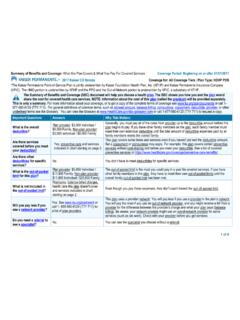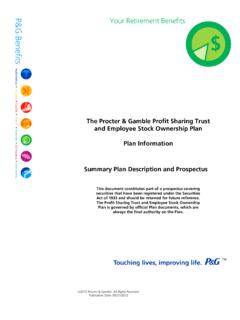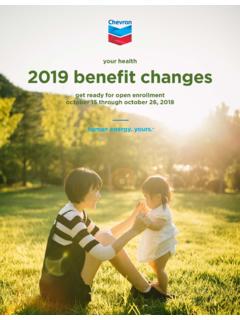Transcription of UPMC DB eSPD - Urban NSS - cache.hacontent.com
1 Retirement 2018. upmc Cash Balance Plan Urban Summary Plan Description This summary plan description (SPD) is provided to you to describe your plan benefits and your rights under the plan. The SPD is based on official plan documents. It is not, nor is it intended to be, the official plan document, or a contract between upmc and any employee, or a guarantee of employment. Every effort has been made to ensure the accuracy of this information. In the unlikely event that there is a discrepancy between the SPD and the official plan documents, the official plan documents will control. upmc reserves the right to amend, suspend, or terminate the plan(s) or program(s) at any time. upmc has the discretionary authority to interpret the terms of the plan(s). summarized in this document and determine your eligibility for benefits under its terms. In addition, there may be situations where the plan(s) provides different benefits to different employee groups.
2 This SPD provides only those benefits that are applicable to you based on your employee group. This SPD is available to you online through the upmc Retirement Center website by logging on to My HUB, clicking on the Human Resources tab, and then clicking on My Retirement under My Benefits. You can also type in your Internet browser. You have access and the ability to view this SPD on the website and to print pages of this SPD from the website. You also have the right to request and receive, free of charge, a printed copy of the electronically delivered document by calling the upmc Retirement Line at 1-877-206-8264. If there are any discrepancies between the information on the website and your printed copy, the website version will control. Table of Contents Cash Balance Plan Overview .. 7. Your Benefit 7. Eligibility to Receive Cash Balance Benefits.
3 7. Separation from Service .. 7. How Benefits Are 8. Eligibility to Participate .. 8. Who is Eligible .. 8. Who is Not Eligible .. 8. Participating Entities/Affiliates of upmc .. 9. When Participation Begins .. 10. Cash Balance Formula .. 10. How the Cash Balance Plan Works .. 10. Components of the Cash Balance Formula .. 10. Retirement Credits .. 11. Interest Credits .. 11. Transition Credits .. 11. General Transition Credits At least Age 50 with 15 Years of Service .. 12. General Transition Credits At least Age 45 with 15 Years of Service .. 12. Transition Credits upmc Shadyside - (At least Age 50 with 15 Years of Service) .. 13. Transition Credits upmc Shadyside - (At least Age 45 with 15 Years of Service) .. 13. Transition Credits - upmc /Jefferson Regional Home Health, LP - (At least Age 50 with 15 Years of Service) .. 14. Transition Credits upmc /Jefferson Regional Home Health, LP - (At least Age 45 with 15 Years of Service).
4 14. Transition Credits - upmc Bedford Memorial - (At least Age 50 with 15 Years of Service).. 15. Transition Credits - upmc Bedford Memorial - (At least Age 45 with 15 Years of Service) .. 15. Transition Credits Home Nursing Agency - (At least Age 50 with 15 Years of Service) .. 16. Transition Credits Home Nursing Agency - (At least Age 45 with 15 Years of Service) .. 16. Transition Credits Home Health Resources - (At least Age 50 with 15 Years of Service) .. 17. Transition Credits Home Health Resources - (At least Age 45 with 15 Years of Service) .. 17. upmc Altoona / upmc Altoona Partnership for a Healthy Community - Transition Credit Schedule 18. Calculating Your Cash Balance Plan Account Value .. 19. 1. Annual Interest Credits .. 19. 2. Retirement Credit 20. 3. Transition Credit Amount .. 21. 4. Cash Balance Account Value .. 21. Cash Balance Effective Date.
5 22. How Your Opening Balance Is Calculated .. 24. How Prior Plan Benefits Affect Your Opening 24. What Service Means .. 24. Hours of Service .. 25. Earning Hours of Service .. 25. Hours of Service Not Credited .. 25. Vesting Service .. 26. Definition of Vesting Service .. 26. Vesting Schedule .. 26. Automatic Vesting .. 26. Benefit Service .. 27. Definition of Benefit Service .. 27. How Benefit Service Is Counted .. 27. Break in Service .. 27. Compensation .. 28. What is Included .. 28. What is Not Included .. 28. Maximum Eligible Annual Compensation .. 28. How Assumptions Impact Benefit Amounts .. 29. Cash Balance Plan Interest Rate .. 29. Your Estimated Annual Pay .. 29. Your Annual Pay Increase Percentage .. 29. Calculating Age plus Benefit Service .. 29. Cash Balance Benefit Assumptions .. 30. When You Can Receive Benefits .. 31. Retirement Eligibility Rules.
6 31. Payment of Benefits .. 31. Normal 31. Normal Retirement Age .. 31. Working After Normal Retirement Age .. 32. Pre-retirement Death Benefits .. 32. Deferred Vested Benefit .. 33. When You Leave upmc .. 33. When You Can Receive Deferred Vested Benefits .. 33. Automatic Lump-Sum Payments .. 33. Disability Retirement .. 34. When Disability Pension Payments Begin .. 34. Disability Pension Benefit Amount .. 34. Total and Permanent Disability .. 35. Returning to Work After a Disability .. 35. Pension Benefit Forms of Payment .. 36. How Your Pension Benefit Is Paid .. 36. Standard Payment 36. Optional Payment Methods .. 36. Naming a Beneficiary .. 37. 37. If You Are Single .. 37. If You Are Married .. 37. How to Make Your Beneficiary Designation .. 37. Retirees .. 37. Single Life 37. Choosing a Payment Option If You Are 38. Payment Options and Your Beneficiary Choice.
7 38. Spousal Consent .. 38. 50% Joint and Survivor Annuity .. 38. Other Joint and Survivor Annuity Options .. 39. Certain and Life Annuity .. 40. Age 62 Social Security Adjustment 41. Lump Sums .. 42. Direct Rollover Payments .. 42. Direct Rollover .. 42. 60-Day 43. Direct Payments to You .. 43. Special Tax Notice .. 43. 10-Year Period Certain 44. 10-Year Certain and Continuous Combined with 66 - 2/3% Contingent Annuitant Option .. 44. Full Cash Refund Annuity .. 44. Minimum Distributions .. 45. Retiree 45. Direct Deposit .. 45. Withholding .. 46. Definition of Withholding .. 46. Withholding on Annuity Payments .. 46. If You Do Not Make a Withholding Choice .. 46. Pension Payment Schedule .. 47. When to Expect Your Payment .. 47. What to Do If Your Payment Is Missing .. 47. Qualified Domestic Relations Order (QDRO).. 47. Important Plan Information.
8 48. Plan Identification .. 48. Plan 48. Plan Trustee .. 48. Service of Legal Process .. 48. Funding Information and Source of 49. Pension Benefits Guarantee Corporation Insured (PBGC) .. 49. Plan Sponsor and Administrator .. 50. Benefit Review 51. Initial Decision .. 51. If Your Benefit Is 51. Request for Review If Your Benefit Is Denied .. 51. Decision on Review .. 52. Situations Affecting Your Benefits .. 53. Changes to the Cash Balance Plan .. 54. If There Are Changes .. 54. If the Plan Ends .. 54. Mergers, Consolidations, or Transfers .. 54. Your Legal Rights under the Plan .. 54. Receive Information about Your Plan and Benefits .. 54. Prudent Actions by Plan Fiduciaries .. 55. Enforce Your Rights .. 55. Assistance with Your Questions .. 56. Cash Balance Plan Overview The upmc Basic Retirement Plan is a Cash Balance Plan (hereinafter Plan ).
9 The Cash Balance Plan is designed to provide income during your retirement. upmc makes all contributions to the Plan, unlike 401(k) plans, where you make contributions from your pay. Company contributions are kept in a trust fund and paid to you when you are eligible to retire. Your pension is based on how long you work for the company and your eligible pay. Generally, benefits are paid monthly throughout your lifetime or you may choose a single lump-sum payment, beginning on your retirement date. Your Benefit Amount Your Cash Balance benefit is based on: Your annual eligible compensation; and Your service--the time you work for the company. Eligibility to Receive Cash Balance Benefits Your age and service determine when you can begin receiving payments from the plan, as well as your eligibility for: Normal retirement Deferred vested benefits Disability pension benefits Because the Plan's purpose is to provide income during retirement, your benefit payments will be highest if you start receiving them at normal retirement age.
10 If you receive payments earlier, the monthly benefit may be reduced because your benefit will be paid over a longer time. Separation from Service If you no longer work for upmc or any of its affiliated companies, you: Have separated from employment for the purposes of the plan; and Forfeit the portion of your pension benefit that is not vested. 7. How Benefits Are Paid You can receive your pension benefit under one of the standard forms of payment or choose an optional payment method. These factors affect your choice: The amount of your benefit How long you want to receive payments If you want your survivors to receive payments after your death Benefit payments are taxable income, so federal and state withholding rules apply. If you become divorced or separated, a Qualified Domestic Relations Order (QDRO) may affect how benefits are paid to you and your beneficiary.











